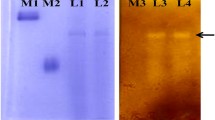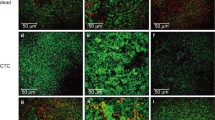Abstract
Dental biofilms represent a serious oral health problem playing a key role in the development of caries and other oral diseases. In the present work, we cloned and expressed in E. coli two glucanases, Prevotella melaninogenica mutanase (PmGH87) and Capnocytophaga ochracea dextranase (CoGH66), and characterized them biochemically and biophysically. Their three-dimensional structures were elucidated and discussed. Furthermore, we tested the capacity of the enzymes to hydrolyze mutan and dextran to prevent formation of Streptococcus mutans biofilms, as well as to degrade pre- formed biofilms in low and abundant sugar conditions. The percentage of residual biofilm was calculated for each treatment group in relation to the control, as well as the degree of synergism. Our results suggest that both PmGH87 and CoGH66 are capable of inhibiting biofilm formation grown under limited or abundant sucrose conditions. Degradation of pre-formed biofilms experiments reveal a time-dependent effect for the treatment with each enzyme alone. In addition, a synergistic and dose-dependent effects of the combined enzymatic treatment with the enzymes were observed. For instance, the highest biomass degradation was 95.5% after 30 min treatment for the biofilm grown in low sucrose concentration, and 93.8% after 2 h treatment for the biofilm grown in sugar abundant condition. Strong synergistic effects were observed, with calculated degree of synergism of 5.54 and 3.18, respectively and their structural basis was discussed. Jointly, these data can pave the ground for the development of biomedical applications of the enzymes for controlling growth and promoting degradation of established oral biofilms.






Similar content being viewed by others
Data Availability
The datasets generated during and/or analyzed during the current study are available from the corresponding author on reasonable request.
Code Availability
Not applicable.
References
Aires CP, Bel Cury D, Tenuta AA, Klein LMA, Koo MI, Duarte H, S., Cury JA (2008) Effect of starch and sucrose on dental biofilm formation and on root dentine demineralization. Caries Res 42(5):380–386. https://doi.org/10.1159/000154783
Bowen WH, Koo H (2011) Biology of streptococcus mutans-derived glucosyltransferases: role in extracellular matrix formation of cariogenic biofilms. Caries Res 45(1):69–86. https://doi.org/10.1159/000324598
Buddana SK, Amrutha RN, Batchu UR, Penna S, Prakasham RS (2019) Mutanase enzyme from Paracoccus mutanolyticus RSP02: characterization and application as a Biocontrol Agent. Indian J Microbiol 59(4):436–444. https://doi.org/10.1007/s12088-019-00821-1
Camilo CM, Polikarpov I (2014) High-throughput cloning, expression and purification of glycoside hydrolases using ligation-independent cloning (LIC). Protein Exp Purif 99(March):35–42. https://doi.org/10.1016/j.pep.2014.03.008
Ccahuana-Vásquez RA, Cury JA (2010) S. mutans biofilm model to evaluate antimicrobial substances and enamel demineralization. Brazilian Oral Research 24(2):135–141. https://doi.org/10.1590/S1806-83242010000200002
Cherdvorapong V, Panti N, Suyotha W, Tsuchiya Y, Toyotake Y, Yano S, Wakayama M (2020) Prevention of oral biofilm formation and degradation of biofilm by recombinant α-1,3-glucanases from streptomyces thermodiastaticus hf3-3. J Gen Appl Microbiol 66(5):256–264. https://doi.org/10.2323/jgam.2019.11.003
Costa Oliveira BE, Cury JA, Ricomini Filho AP (2017) Biofilm extracellular polysaccharides degradation during Starvation and enamel demineralization. PLoS ONE 17(7):e0181168. https://doi.org/10.1371/journal.pone.0181168
Cox MS, Deblois CL, Suen G (2021) Assessing the response of Ruminal bacterial and fungal microbiota to whole-rumen contents exchange in dairy cows. Front Microbiol 12(June). https://doi.org/10.3389/fmicb.2021.665776
Cury JA, Rebelo MA, Del Bel Cury AA, Derbyshire MT, Tabchoury CP (2000) Biochemical composition and cariogenicity of dental plaque formed in the presence of sucrose or glucose and fructose. Caries Res 34(6):491–497. https://doi.org/10.1159/000016629
Davies GJ, Wilson KS, Henrissat B (1997) Nomenclature for sugar-binding subsites in glycosyl hydrolases. Biochem J 321(2):557–559. https://doi.org/10.1042/bj3210557
Finnegan PM, Brumbley SM, O’Shea MG, Nevalainen H, Bergquist PL (2004) Isolation and characterization of genes encoding thermoactive and thermostable dextranases from two thermotolerant soil bacteria. Curr Microbiol 49(5):327–333. https://doi.org/10.1007/s00284-004-4308-5
Fujimoto Z, Kishine N, Suzuki N, Suzuki R, Mizushima D, Momma M, Kimura K, Funane K (2017) Isomaltooligosaccharide-binding structure of Paenibacillus Sp. 598K Cycloisomaltooligosaccharide glucanotransferase. Biosci Rep 37(2):1–12. https://doi.org/10.1042/BSR20170253
Hawkey PM, Malnick H, Glover SAM, Cook N, Watts JA (1984) Capnocytophaga ochracea Infection: two cases and a review of the published work. J Clin Pathol 37(9):1066–1070. https://doi.org/10.1136/jcp.37.9.1066
Hayacibara MF, Koo H, Vacca Smith AM, Kopec LK, Scott-Anne K, Cury JA, Bowen WH (2004) The influence of mutanase and dextranase on the production and structure of glucans synthesized by streptococcal glucosyltransferases. Carbohydr Res 339(12):2127–2137. https://doi.org/10.1016/j.carres.2004.05.031
Hoster F, Daniel R, Gottschalk G (2001) Isolation of a new Thermoanaerobacterium thermosaccharolyticum strain (FH1) producing a thermostable dextranase. J Gen Appl Microbiol 47(4):187–192. https://doi.org/10.2323/jgam.47.187
Hu X-Q, Xia B-B, Ru W-J, Zhang Y-X, Yang J-W, Zhang H-B (2023) Research progress on structure and catalytic mechanism of dextranase. EFood 44(20):2014–2017. https://doi.org/10.1002/efd2.60
Huang R, Zhong L, Xie F, Wei L, Gan L, Wang X, Liao A (2019) Purification, characterization and degradation performance of a novel dextranase from penicillium cyclopium CICC-4022. Int J Mol Sci 20(6). https://doi.org/10.3390/ijms20061360
Itoh T, Intuy R, Suyotha W, Hayashi J, Yano S, Makabe K, Wakayama M, Hibi T (2020) Structural insights into substrate recognition and catalysis by glycoside hydrolase family 87 α-1,3-glucanase from Paenibacillus glycanilyticus FH11. FEBS J 287(12):2524–2543. https://doi.org/10.1111/febs.15161
Jakubovics NS, Goodman SD, Mashburn-Warren L, Stafford GP, Cieplik F (2021) The dental plaque biofilm matrix. Periodontol 2000 86(1):32–56. https://doi.org/10.1111/prd.12361
Janket S-J, Kanasi E, Baird AE (2015) Chapter 58 - Oral Infections and Autoimmune Diseases (Y. Shoenfeld, N. Agmon-Levin, & N. R. B. T.-I. and A. (Second E. Rose (eds.); pp. 959–980). Academic Press. https://doi.org/10.1016/B978-0-444-63269-2.00063-5
Johansen C, Falholt P, Gram L (1997) Enzymatic removal and disinfection of bacterial biofilms. Appl Environ Microbiol 63(9):3724–3728. https://doi.org/10.1128/aem.63.9.3724-3728.1997
Jumper J, Evans R, Pritzel A, Green T, Figurnov M, Ronneberger O, Tunyasuvunakool K, Bates R, Žídek A, Potapenko A, Bridgland A, Meyer C, Kohl SAA, Ballard AJ, Cowie A, Romera-Paredes B, Nikolov S, Jain R, Adler J, …, Hassabis D (2021) Highly accurate protein structure prediction with AlphaFold. Nature 596(7873):583–589. https://doi.org/10.1038/s41586-021-03819-2
Kaplan JB (2009) Therapeutic Potential of biofilm-dispersing Enzymes 32(9):545–554
Klein MI, Hwang G, Santos PHS, Campanella OH, Koo H (2015) Streptococcus mutans-derived extracellular matrix in cariogenic oral biofilms. Front Cell Infect Microbiol 5(FEB):1–8. https://doi.org/10.3389/fcimb.2015.00010
Lin Y, Chen J, Zhou X, Li Y (2021) Inhibition of Streptococcus mutans biofilm formation by strategies targeting the metabolism of exopolysaccharides. Crit Rev Microbiol 47(5):667–677. https://doi.org/10.1080/1040841X.2021.1915959
Lin Y, Zhou X, Li Y (2022) Strategies for Streptococcus mutans biofilm dispersal through extracellular polymeric substances disruption. Mol Oral Microbiol 37(1):1–8. https://doi.org/10.1111/omi.12355
Mattos-Graner RO, Zelante F, Line RC, Mayer MP (1998) Association between caries prevalence and clinical, microbiological and dietary variables in 1.0 to 2.5-year-old Brazilian children. Caries Res. ;32(5):319 – 23. https://doi.org/10.1159/000016466. PMID: 9701655
Mattos-Graner RO, Smith DJ, King WF, Mayer MP (2000) Water-insoluble glucan synthesis by mutans streptococcal strains correlates with caries incidence in 12- to 30-month-old children. J Dent Res. ;79(6):1371-7. https://doi.org/10.1177/00220345000790060401. PMID: 10890715
Nobre dos Santos M, Melo dos Santos L, Francisco SB, Cury JA Relationship among dental plaque composition, daily sugar exposure and caries in the primary dentition. Caries Res. 2002 Sep-Oct;36(5):347 – 52. https://doi.org/10.1159/000065959. PMID: 12399695
Nyvad B, Takahashi N (2020) Integrated hypothesis of dental caries and periodontal Diseases. J Oral Microbiol 12(1). https://doi.org/10.1080/20002297.2019.1710953
Otsuka R, Imai S, Murata T, Nomura Y, Okamoto M, Tsumori H, Kakuta E, Hanada N, Momoi Y (2015) Application of chimeric glucanase comprising mutanase and dextranase for prevention of dental biofilm formation. Microbiol Immunol 59(1):28–36. https://doi.org/10.1111/1348-0421.12214
Park TS, Jeong HJ, Ko JA, Ryu YB, Park SJ, Kim D, Kim YM, Lee WS (2012) Biochemical characterization of thermophilic dextranase from a thermophilic bacterium, Thermoanaerobacter pseudethanolicus. J Microbiol Biotechnol 22(5):637–641. https://doi.org/10.4014/jmb.1112.12024
Pleszczyńska M, Wiater A, Janczarek M, Szczodrak J (2015) (1→3)-α-d-Glucan hydrolases in dental biofilm prevention and control: a review. Int J Biol Macromol 79:761–778. https://doi.org/10.1016/j.ijbiomac.2015.05.052
Rølla G (1989) Why is sucrose so cariogenic? The role of glucosyltransferase and polysaccharides. Eur J Oral Sci 97(2):115–119. https://doi.org/10.1111/j.1600-0722.1989.tb01439.x
Shimotsuura I, Kigawa H, Ohdera M, Kuramitsu HK, Nakashima S (2008) Biochemical and molecular characterization of a novel type of mutanase from Paenibacillus sp. strain RM1: identification of its mutan-binding domain, essential for degradation of Streptococcus mutans biofilms. Appl Environ Microbiol 74(9):2759–2765. https://doi.org/10.1128/AEM.02332-07
Spinola MS, Nóbrega DF, Bel Cury D, Filho A. A., Ricomini, Cury AP, J. A., Tenuta LMA (2019) Fluoride penetration and clearance are higher in exopolysaccharide-containing bacterial pellets. Caries Res 53(1):16–23. https://doi.org/10.1159/000488596
Suyotha W, Yano S, Itoh T, Fujimoto H, Hibi T, Tachiki T, Wakayama M (2014) Characterization of α-1,3-glucanase isozyme from Paenibacillus glycanilyticus FH11 in a new subgroup of family 87 α-1,3-glucanase. J Biosci Bioeng 118(4):378–385. https://doi.org/10.1016/j.jbiosc.2014.03.008
Suyotha W, Yano S, Wakayama M (2016) α-1,3-Glucanase: present situation and prospect of research. World J Microbiol Biotechnol 32(2):1–11. https://doi.org/10.1007/s11274-015-1977-0
Suzuki N, Fujimoto Z, Kim YM, Momma M, Kishine N, Suzuki R, Suzuki S, Kitamura S, Kobayashi M, Kimura A, Funane K (2014) Structural elucidation of the cyclization mechanism of α-1,6-Glucan by Bacillus Circulans T-3040 Cycloisomaltooligosaccharide glucanotransferase. J Biol Chem 289(17):12040–12051. https://doi.org/10.1074/jbc.M114.547992
Suzuki N, Kishine N, Fujimoto Z, Sakurai M, Momma M, Ko JA, Nam SH, Kimura A, Kim YM (2015) Crystal structure of thermophilic dextranase from Thermoanaerobacter pseudethanolicus. J BioChem 159(3):331–339. https://doi.org/10.1093/jb/mvv104
Wang X, Cheng H, Lu M, Fang Y, Jiao Y, Li W, Zhao G, Wang S (2016) Dextranase from Arthrobacter oxydans KQ11-1 inhibits biofilm formation by polysaccharide hydrolysis. Biofouling 32(10):1223–1233. https://doi.org/10.1080/08927014.2016.1239722
Wiater A, Szczodrak J, Rogalski J (2004) Hydrolysis of mutan and prevention of its formation in streptococcal films by fungal α-D-glucanases. Process Biochem 39(11):1481–1489. https://doi.org/10.1016/S0032-9592(03)00281-4
Xiao J, Klein MI, Falsetta ML, Lu B, Delahunty CM, Yates JR, Heydorn A, Koo H (2012) The exopolysaccharide matrix modulates the interaction between 3D architecture and virulence of a mixed-species oral biofilm. PLoS Pathog 8(4):7–9. https://doi.org/10.1371/journal.ppat.1002623
Yano S, Wakayama M, Tachiki T (2006) Cloning and expression of an α-1,3-glucanase gene from Bacillus circulans KA-304: the enzyme participates in protoplast formation of Schizophyllum commune. Bioscience Biotechnol Biochem 70(7):1754–1763. https://doi.org/10.1271/bbb.60095
Yano S, Suyotha W, Oguro N, Matsui T, Shiga S, Itoh T, Hibi T, Tanaka Y, Wakayama M, Makabe K (2019) Crystal structure of the catalytic unit of GH 87-type α-1,3-glucanase Agl-KA from Bacillus circulans. Sci Rep 9(1):1–10. https://doi.org/10.1038/s41598-019-51822-5
Funding
This work was supported by Fundação de Amparo à Pesquisa do Estado de São Paulo (FAPESP) via grants 2021/08780-1 and 2020/15092-1, and by Conselho Nacional de Desenvolvimento Científico e Tecnológico (CNPq) via grants 306852/2021-7 and 440180/2022-8.
Author information
Authors and Affiliations
Contributions
All authors contributed to the study conception and design. Material preparation, data collection and analysis were performed by Anelyse Abreu Cortez, Mateus Xavier de Queiroz and Caio Cesar de Mello Capetti. The first draft of the manuscript was written by Anelyse Abreu Cortez and all authors commented on previous versions of the manuscript. All authors read and approved the final manuscript.
Corresponding author
Ethics declarations
Competing interests
The authors declare no competing interests.
Ethics approval
Not applicable.
Consent to participate
Not applicable.
Consent for publication
All authors mutually agree that the manuscript should be submitted to World Journal of Microbiology and Biotechnology.
Additional information
Publisher’s Note
Springer Nature remains neutral with regard to jurisdictional claims in published maps and institutional affiliations.
Electronic supplementary material
Below is the link to the electronic supplementary material.
Rights and permissions
Springer Nature or its licensor (e.g. a society or other partner) holds exclusive rights to this article under a publishing agreement with the author(s) or other rightsholder(s); author self-archiving of the accepted manuscript version of this article is solely governed by the terms of such publishing agreement and applicable law.
About this article
Cite this article
Cortez, A.A., de Queiroz, M.X., de Oliveira Arnoldi Pellegrini, V. et al. Recombinant Prevotella melaninogenica α-1,3 glucanase and Capnocytophaga ochracea α-1,6 glucanase as enzymatic tools for in vitro degradation of S. mutans biofilms. World J Microbiol Biotechnol 39, 357 (2023). https://doi.org/10.1007/s11274-023-03804-z
Received:
Accepted:
Published:
DOI: https://doi.org/10.1007/s11274-023-03804-z




